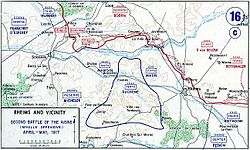
Back Bataille des monts de Champagne French Pertempuran Bukit ID Battaglia delle Colline Italian Третя шампанська битва Ukrainian 香檳山戰役 Chinese
| Battle of the Hills | |||||||
|---|---|---|---|---|---|---|---|
| Part of the Western Front of the First World War | |||||||
 The front line at various stages in the battle, with the Battle of the Hills on the right of the image. | |||||||
| |||||||
| Belligerents | |||||||
|
|
| ||||||
| Commanders and leaders | |||||||
|
Robert Nivelle Philippe Pétain François Anthoine |
Erich Ludendorff Crown Prince Wilhelm Karl von Einem | ||||||
| Strength | |||||||
| 13 divisions | 17 divisions | ||||||
| Casualties and losses | |||||||
| 21,697 | 6,120 prisoners | ||||||
The Battle of the Hills (French: Bataille des Monts) also known as the Battle of the Hills of Champagne and the Third Battle of Champagne, was a battle of the First World War that was fought from April–May 1917. The French Fourth Army offensive against the German 4th Army was to support the Groupe d'armées du Nord (GAN, Northern Army Group) along the Chemin des Dames, in the Second Battle of the Aisne.[a] General Anthoine, commander of the Fourth Army planned a supporting attack but this was rejected by Nivelle and Anthoine planned a frontal attack by two corps on an 11 km (6.8 mi) front, to break through the German defences on the first day and commence exploitation the following day. The battle took place east of Reims, between Prunay and Aubérive, in the province of Champagne, along the Moronvilliers Hills.[b]
On the left of XII Corps to the east of the Suippes river, the 24th Division established a flank guard by attacking through Bois des Abattis towards Germains and Baden-Baden trenches. On the left flank of the division, Aubérive on the east bank of the river was rapidly captured. On the west bank of the Suippes, the 75th Territorial Regiment (Moroccan Division) made progress round the main part of Aubérive. The Moroccan Division was repulsed on its extreme right but the Régiment de marche de la Légion étrangère (March Regiment of the Foreign Legion) gained a foothold at Le Golfe. North-east of Mont Haut, the advance reached a depth of 2.4 km (1.5 mi) and next day the advance was pressed further. To the west, the French 34th Division took Mont Cornillet and Mont Blond and the 16th Division was repulsed at Bois de la Grille.
The French spent 18 April consolidating and the 45th Division pushed up to the southern edge of Mont Haut. The "Monts" were held against a German counter-attack on 19 April, between Nauroy and Moronvilliers, by the 5th Division and 6th Division, which had been trained as Eingreifdivisionen (specialist counter-attack divisions), supported by the 23rd Division plus one regiment. Next day, the French 33rd Division captured Le Téton and the capture of Aubérive was completed by the 24th Division and the Territorial battalions. On 20 April, French troops got onto the summit of Le Casque and on 22 April, the eastern and lower summit of Mont Haut was secured by the 45th Division.
The Fourth Army took 3,550 prisoners and 27 guns. Counter-attacks by the German 4th Army on 27 May had temporary success, before the French recaptured ground around Mont Haut; lack of troops had forced the Germans into piecemeal attacks, instead of a simultaneous attack all along the front. The French attacked again from 17 to 22 April and despite German counter-attacks on 19 and 23 April, advanced slightly on the Heights of Moronvilliers. After a lull, the French attacked again on 30 April and ended the offensive on 20 May. The number of German prisoners taken by the end of the battle had been increased to 6,120, with 52 guns, 42 mortars and 103 machine-guns.
Cite error: There are <ref group=lower-alpha> tags or {{efn}} templates on this page, but the references will not show without a {{reflist|group=lower-alpha}} template or {{notelist}} template (see the help page).
- ^ Sheldon 2015, p. 172.